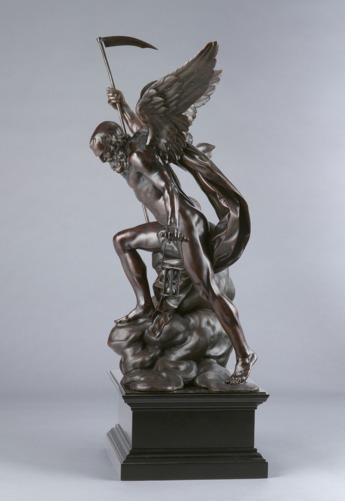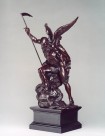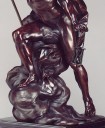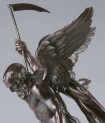Attributed to Giuseppe Piamontini (1664-1742), or his circle
Italian, Late 17th-Early 18th Century
An Allegory of Time.
Bronze. Height (to top of scythe) 24½" (62.5cm).
The suggestion of Piamontini or his circle for this bronze is because of features which appear definitely Italian, and particularly Florentine, rather than French, and because of similarities with known and attributed work of Piamontini. The finely chased surfaces and fine punching of this present Chronos figure is like that of Piamontini bronzes, and his Florentine contemporaries and near contemporaries. The unusual cloud base, on which Chronos sits, can be compared closely with the use of the same device in a pair of bronzes of Jupiter and Juno attributed to Piamontini in the Ashmolean Museum, Oxford,(1) an almost identical pair of which are in the Philadelphia Museum of Art.(2) The attribution to Piamontini of the Philadelphia bronzes was first proposed by Jennifer Montagu.(3) This cloud base is also seen in another pair of bronzes in the Minneapolis Institute of Arts, of Leda and Ganymede, which are ascribed to Piamontini, a version of the Ganymede also in the Palazzo Corsini, Rome.(4) The figure of Leda is particularly interesting here, in that the clouds are used as a device to shield the goddess's modesty, rather than drapery, this unusual feature also found in the present bronze.
There are other similarities with the work of Piamontini, most particularly in the vigorous modelling of Chronos's head, his divided wavy beard, and the particular treatment of his incised eyes, all of which can be compared with Piamontini's signed and dated group of the Sacrifice of Isaac.(5) A lesser, but interesting, point is the skilful joining of separately cast elements that is evident in the present Chronos figure, which Penny notes is also the case with the pair of bronzes of Jupiter and Juno, in both the Ashmolean and Philadelphia versions.(6) In particular, the right arm of Jupiter, in both the Ashmolean and the Philadelphia versions, is separately cast and joined just below the shoulder, as are both arms of the present figure. Penny points out that this method of construction is characteristic of Florentine foundries, such as that of Soldani, though adds that Parisian founders became adept at this practice as well.(7)
There is a possible interesting connection with the models by Piamontini for the Doccia factory. The Minneapolis Ganymede has a counterpart in a Doccia model by Piamontini, and in Jennifer Montagu's article suggesting the attribution of the pair of Philadelphia bronzes of Jupiter and Juno, she identified two Doccia models of Jupiter and Juno by Piamontoni which she proposed corresponded with these sculptures. With regard to the present bronze, an allegorical figure of Time (Un Tempo) is listed amongst the models by Giuseppe Piamontini purchased by Carlo Ginori at the Doccia factory, Florence, c. 1750. These models were sold by the sculptor's son, Giovanni Battista Piamontini, following his father's death. This figure has never been identified, and is not yet known in Doccia porcelain, although there is another allegorical figure of Time, by Giovanni Battista Foggini, which was used by the factory, surmounting the Tempietto dedicato alle Glorie della Toscana, in the Accademia Etrusca in Cortona. It is conceivable that the present bronze figure could be Piamontini's model, in which case the comparatively large size and the fact that it is clearly meant to be viewed from below, suggest that it may have been intended to surmount a large Florentine cabinet incorporating a clock.
____________________________
Footnotes
1. See Nicholas Penny, Catalogue of European Sculpture in the Ashmolean Museum, 1992, Vol. I, nos. 70 & 71, pp. 92-94.
2. Wilstach Collection (W. 68-1-1 & 68-1-2), and illustrated in Dimitrios Zikos, Giuseppe Piamontini; Il Sacrificio di Isacco de Anna Maria Luisa de' Medici, Elettrice Palatina, exhibition catalogue, Galleria Carlo Orsi, Milan, September 2005, figs. 25 & 26, p. 42.
3. Jennifer Montagu, 'Some Small Sculptures by Giuseppe Piamontini', Antichità viva, 1974 (unpaginated).
4. Zikos, op. cit., figs. 27 & 28, p. 43.
5. Zikos, op. cit., passim.
6. Penny, op. cit., p. 92.
7. Penny, ibid.
8. See Repertorio della Scultura Fiorentina del Seicento e Settecento, ed. Giovanni Pratesi, 1993, Vol. III, fig. 438, this model in the Museo di Doccia, Sesto Fiorentino.
9. Quoted in Penny, op. cit., p. 92.
10. Archivio Ginori Lisci, Filza 137, 1, No. 2. We are grateful to Trinity Fine Art for this, and the following, reference.
11. See the exhibition catalogue, Le Statue del Marchese Ginori, Florence, 2003, no. 17, pp. 88-91.





